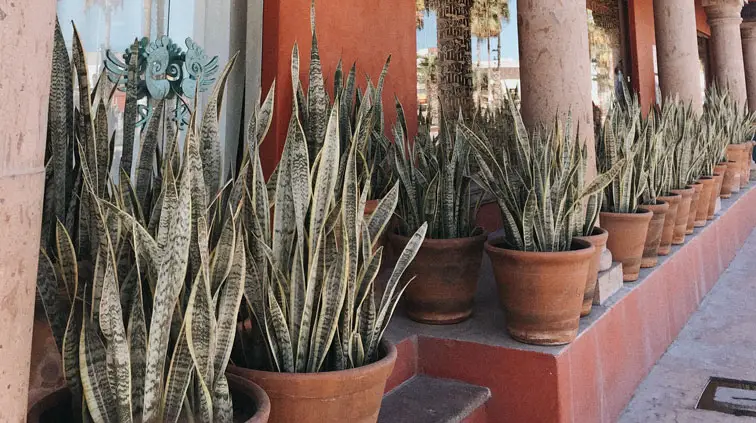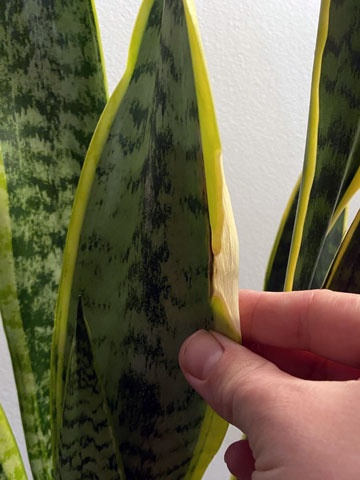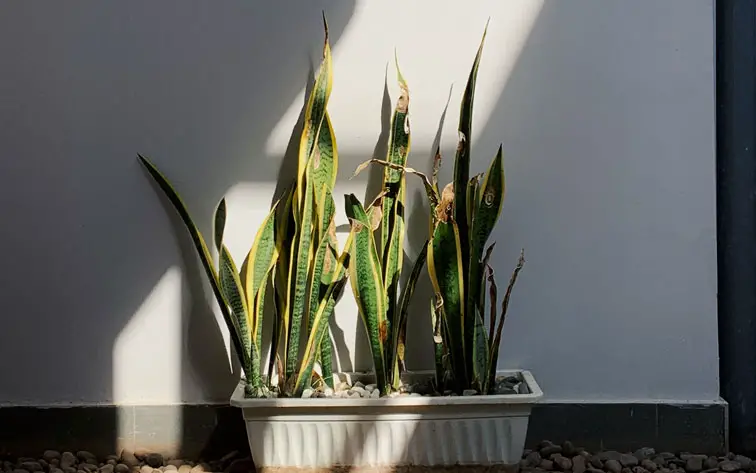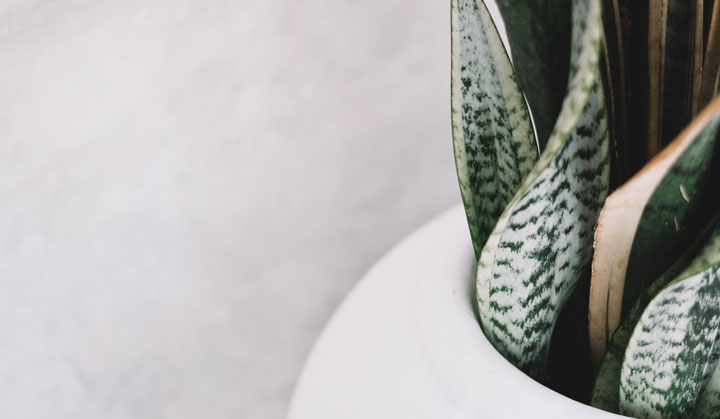5 Signs Your Snake Plant Needs Watering

This post follows our research editorial guidelines.

Snake plants are some of the easiest houseplants to take care of. They’re highly resilient and incredibly low maintenance. I’d say they’re pretty much the perfect indoor plants! However, even the most neglectful plant parent will eventually need to water their snake plant. If not, the plant will start showing signs of drought stress.
In this article, I’ll share with you the 5 most common signs that your snake plant is thirsty and needs watering. Keep reading to learn more!

Table of Contents
How to Tell if Your Snake Plant Needs Water
Snake plants are known to be vulnerable to overwatering, which is why many owners err on the side of underwatering. As a result, it can be tricky to tell when your plant needs watering.
Here are the 5 most common signs that your snake plant is thirsty:
1. Leaves Turning Yellow or Brown

The snake plant is known for its vividly green leaves, so if you start to see yellow or brown patches, it’s a clear sign that something is wrong. While there are several reasons why this may happen, one of the most common is underwatering.
When snake plants don’t get enough water, their leaves will start to turn yellow or brown and eventually drop off. This is because when there’s no water to carry nutrients to the foliage, the chlorophyll-containing cells start to die, causing the leaves to lose their green color.
If you notice that your plant’s leaves are turning yellow or brown, the first thing you should do is check the soil. If it’s dry, water your plant and see if the leaves start to return to their normal color. If they don’t, there could be another problem, such as root rot or a nutrient deficiency.
2. Drooping Leaves
When snake plants don’t get enough water, their leaves will start to droop and sag. This is because the plant is trying to prevent water loss by closing its stomata or tiny pores on the surface of the leaves.
If you see that your plant’s leaves are no longer in the signature upright position, get a good feel of the potting mix. If it’s dry 1 inch down, water your plant and see if the leaves start to perk up.
Drooped leaves can also be a sign of overwatering, so if you’re not sure whether your plant is thirsty or not, check the roots. If they’re mushy or smell sour, it’s a tell-tale sign that the plant is getting too much water.
3. Dry Soil
This one is pretty obvious. One of the easiest ways to tell if your plant needs water is to check the soil. If the top inch of the soil is dry to touch, it’s time to water your snake plant.
By closely monitoring the potting mix, you can get a feel for how often your plant needs watering. As a general rule of thumb, snake plants tend to dry out completely between weekly waterings. Depending on the temperature and humidity in your home, this could even happen every two weeks or so.
While simply looking at the soil is a quick and easy way to tell if your plant needs watering, it’s not always foolproof. The only way to be 100% sure that your plant needs water is to stick your finger in the potting mix. If the mix feels dry several inches down, it’s time to water.
If you notice that the soil is shrinking away from the sides of the pot and is hard-packed, this is a sign that the plant has been underwatered for too long. In this case, you’ll need to water more often to help the plant recover.
For even better results, I recommend using a soil moisture meter. These devices are designed to help gardeners (and plant parents!) check the moisture levels in their plants. By sticking the meter into the potting mix, you can get an accurate reading of how wet or dry the soil is.
4. Wrinkly Leaves
Like other succulents, snake plants have fleshy leaves that help store water and moisture. When the plant isn’t getting enough water, the leaves will start to wrinkle and pucker as they try to conserve moisture.

If you see that the blades on your snake plant are looking like your fingers after a long soak in the tub, it’s time to give the plant a good drink. Keep in mind that it’s normal for the bottom leaves of the plant to wrinkle and die off over time, so unless the soil is dry, don’t worry too much about it.
You’ll be surprised to learn that another reason why snake plant leaves may start to wrinkle is because the plant is getting too much water. When succulents are overwatered, their roots can become choked with water and start to rot. This, in turn, prevents the plant from taking up moisture, causing the leaves to wilt and wrinkle.
So, if you notice that your snake plant’s leaves are wrinkling, it’s important to check the soil before assuming that the plant needs more water.
5. Wilting, Curling, or Crumbling Leaves
Plants have certain defense mechanisms against water loss, such as closing their stomata or shedding leaves. If you see that your snake plant’s leaves are wilting, curling, or crumbling, it’s a sign that the plant is severely dehydrated and is struggling to conserve moisture.
If you think your plant is in this condition, it’s important to act quickly. First, check the soil to see if it’s dry. If it is, water your plant and see if the leaves start to recover. If they don’t, or if the roots are mushy or smelly, it’s a sign of root rot, and you’ll need to repot your plant in a fresh, well-draining potting mix.
How to Tell if a Snake Plant has been Overwatered?
As I’ve mentioned, too much water is just as harmful to a snake plant as too little. In fact, overwatering is one of the most common problems people have with snake plants.
So, how can you tell if your snake plant has been overwatered? Here are a few signs to look out for:
- The leaves start to become squishy, limp, or mushy, causing them to lose their structural integrity and eventually collapse.
- The soil starts smelling sour or moldy due to the presence of bacteria and fungi.
- The leaves start to turn yellow, brown, or black and fall off.
- The signature dark green color of the leaves starts to fade.
- The plant becomes stunted or distorted due to the lack of oxygen in the roots.
I know what you’re thinking: all of these signs could also be caused by underwatering! And you’re right, they could be. However, if you notice any of these signs and you know that you’ve been watering your plant regularly, it’s more likely that overwatering is to blame.
You can also shove your finger an inch or two into the soil to see how wet (or dry) it is. If it’s soggy or dripping wet, it’s a sign that your plant is getting too much water.

How Long Can a Snake Plant Go Without Water?
Unlike some borderline dramatic plants (I’m looking at you, fiddle leaf fig), snake plants are pretty resilient and can withstand long periods of drought.
In fact, most snake plants can go for up to 2 weeks without being watered. That said, it’s best to err on the side of caution and water your plant every 7-10 days, especially if it’s growing in a pot.
If you’re not sure whether your plant needs water or not, you know the drill: check the soil! If it’s dry an inch or two down, give your plant a drink.
Do Snake Plants Need Misting?
Misting is usually a good idea for plants, as it helps to increase humidity and prevent the leaves from drying out. However, snake plants don’t really benefit from misting, as they’re native to arid regions and are used to dry conditions.
The thick leaves of a snake plant also help to prevent water loss, so misting is usually unnecessary. In fact, too much moisture can actually do more harm than good, as it can lead to fungal growth or root rot.
How Do I Revive My Snake Plant?
If your snake plant is looking a little worse for wear, don’t despair! There are a few things you can do to revive it.
First, check the soil to see if it’s dry. If it is, water your plant and see if the leaves start to recover. If they don’t, or if the roots are mushy or smelly, it’s a sign of root rot, and you’ll need to repot your plant in fresh, well-draining potting mix.
If the leaves are wilted or yellowed, but the roots seem healthy, it’s a sign of dehydration. To revive your plant, soak the roots in water for an hour or so, then allow the plant to dry before putting it back in its pot.
Finally, if your plant is just looking a bit sad (leaves dropped) and weary, give it a good pruning. Cut off any yellow, brown, or black leaves, as well as any stems that look like they’re dying. This will encourage your plant to put its energy into growing new, healthy leaves.

Why Does My Snake Plant Have Brown Tips?
Brown tips on a snake plant are like a canary in a coal mine: they’re usually a sign that something is wrong.
Some causes of brown tips include:
- Overwatering: If the soil is too wet, the roots can’t get the oxygen they need to function properly. This causes stress to the plant, which manifests as brown tips on the leaves.
- Underwatering: Not enough water can also cause stress to the plant, which leads to brown tips.
- Nutrient Deficiencies: If your plant isn’t getting the nutrients it needs, it can start to show signs of stress, including brown tips on the leaves. You can fix this by using a fertilizer.
- Temperature Extremes: Both too much heat and too much cold can cause brown tips.
- Pests: If your plant is infested with pests, they can suck the sap out of the leaves, causing them to turn brown and die.
Final Thoughts
Snake plants aren’t difficult to care for, but it’s important to be aware of the signs that your plant is thirsty. By paying attention to the leaves and soil, you can keep your snake plant healthy and happy for years to come!
All you need to do is water them weekly and make sure they are getting 1-2 hours of sun exposure every day. Minimal care and regular monitoring goes a long way when it comes to having indoor plants.
